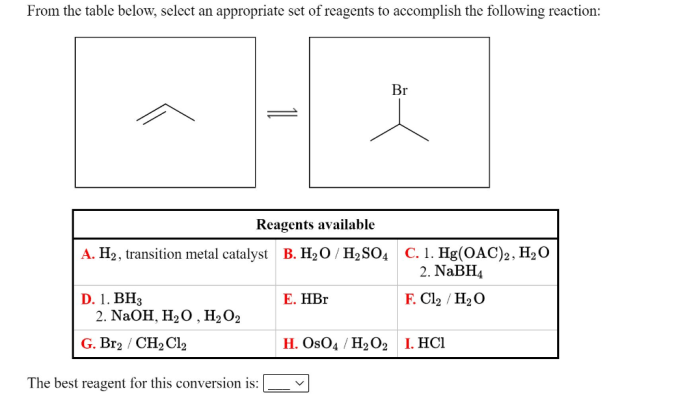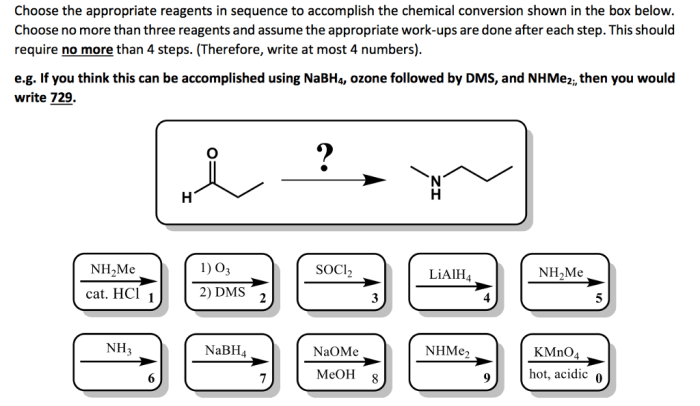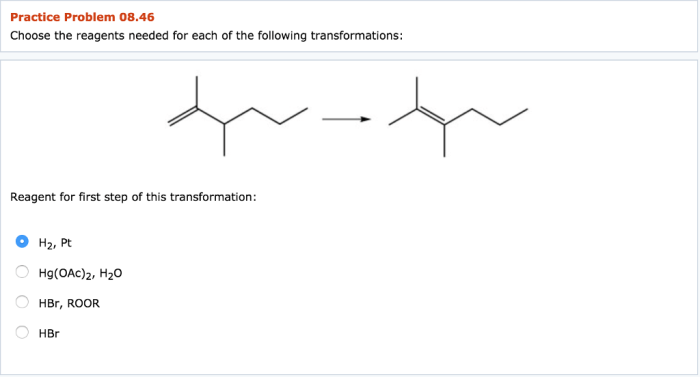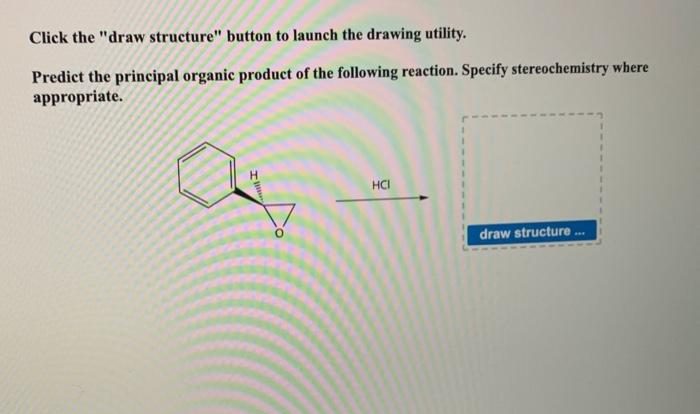Choose the appropriate reagents for the following transformation – Choosing the appropriate reagents for a chemical transformation is a critical step in organic synthesis. The selection of reagents depends on various factors, including reactivity, selectivity, cost, and environmental impact. This article provides an overview of the methods used to select appropriate reagents and discusses the key properties of reagents that influence their reactivity, selectivity, and regiochemistry.
Methods for Reagent Selection

To select appropriate reagents for a given chemical transformation, several methods can be employed. One common approach involves searching the scientific literature for relevant articles or reviews. These sources often provide detailed information on the reagents used, their reactivity, selectivity, and potential side reactions.
Another useful method is to consult chemical databases, such as SciFinder or Reaxys. These databases contain a vast collection of chemical reactions and can be searched using various criteria, including the starting materials, desired products, and reaction conditions. By filtering the search results based on desired properties, such as selectivity or cost, researchers can identify potential reagents for their transformation.
Finally, reaction prediction software can be used to predict the outcome of a chemical reaction and suggest suitable reagents. These software programs employ computational methods to analyze the electronic structure of reactants and products, and estimate the reaction rates and selectivities.
By inputting the desired starting materials and products, researchers can obtain a list of potential reagents and their predicted reactivity.
Reagent Properties and Reactivity
The reactivity of a reagent is influenced by several key properties, including its functional groups, polarity, and steric hindrance. Functional groups, such as hydroxyl, carbonyl, and amine groups, determine the chemical reactivity of a molecule and its ability to undergo specific reactions.
Polarity refers to the separation of charge within a molecule. Polar molecules have a positive end and a negative end, which can interact with other molecules through electrostatic forces. Polarity influences the solubility, reactivity, and selectivity of reagents.
Steric hindrance refers to the physical hindrance caused by the presence of bulky groups around a reaction site. Bulky groups can block access to the reaction site and hinder the approach of other molecules, thereby reducing the reactivity of the reagent.
Selectivity and Regiochemistry
Selectivity refers to the ability of a reagent to react with a specific functional group or atom in a molecule, while leaving other functional groups or atoms unreacted. Regiochemistry refers to the regioselectivity of a reaction, which is the ability to control the position at which a new bond is formed.
The choice of reagents can significantly influence the selectivity and regiochemistry of a reaction. By selecting reagents that are selective for a particular functional group or position, researchers can achieve the desired product with high yield and purity.
Cost and Availability: Choose The Appropriate Reagents For The Following Transformation

The cost and availability of reagents are important factors to consider when selecting reagents for a chemical transformation. Expensive reagents may be necessary for certain reactions, but they can also limit the scalability and economic viability of a process.
The availability of reagents can also be a concern, especially for specialized or hazardous chemicals. Researchers may need to consider alternative reagents or synthetic routes if the desired reagent is not readily available or is subject to regulatory restrictions.
Environmental Considerations

The use of certain reagents can have a significant environmental impact. Some reagents are toxic, flammable, or corrosive, and their use requires special handling and disposal procedures.
Researchers should consider the environmental impact of their choice of reagents and strive to use environmentally friendly alternatives whenever possible. This can involve using non-toxic or biodegradable reagents, minimizing the use of hazardous chemicals, and implementing waste minimization strategies.
Questions and Answers
What are the key factors to consider when selecting reagents?
Reactivity, selectivity, cost, and environmental impact are the key factors to consider when selecting reagents.
How can literature search help in reagent selection?
Literature search can provide information on the reactivity and selectivity of different reagents for a particular transformation.
What is the importance of regiochemistry in reagent selection?
Regiochemistry determines the regioselectivity of a reaction, which is the preference for one regioisomer over another.

